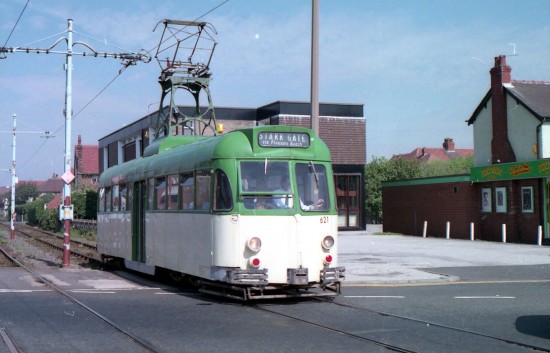With Blackpool Brush 621 enjoying a rare weekend in the spotlight last weekend as part of the Beamish’s Power from the Past event what better tram to feature in tonight’s Picture in Time feature? We head back over 20 years to 1993 when although the Blackpool Tramway wasn’t really in its heyday anymore was still a very different beast to that which was all know today.
As always let’s start with a brief history of the tram which was, of course, the first of the Brush Railcoaches being built in Loughborough during 1937 and then entered service in Blackpool on 20th July 1937 numbered 284. The 1968 renumbering saw the tram take on the number 621 and over the next couple of decades it was to receive modernisation including the fitting of single indicators at the end of 1980 (the last of the surviving Brush Cars to receive these) and then halfway through 1991 it lost its trolley pole in favour of a pantograph. It has carried five different advertising liveries during its career starting off in 1984 when it received a Pleasure Beach advert and ending in 2000 when it received the all over advert it still carries today for the Hot Ice Show – the third time it has advertised this production.
Although many of you reading this will mainly remember 621 for its all over adverts – it last carried the green and cream in mid 1995 – our photo today features the tram carrying fleet livery. It is seen here approaching Cleveleys with a service for Starr Gate on 31st August 1993.


Looks better than some of the over-modified Brush cars. I do wish that they hadn’t put diamond pantos on the old cars though. It looks well out of place.
Bring back the trolley poles.
I doubt many tram crews would agree with that sentiment, especially in wet and windy weather!
With pantographs you don’t have to creep through the frogs and you don’t get dewirements.
And a dewired freely swinging pole risks doing serious GBH to the overheads. Trams at Blackpool are not restricted to museum line speeds.
Yes you do get dewirements! Plenty of damaged pans have pulled down overhead. Tends to be more terminal as a trolley can usually be rewired, pantos tend to be ruined
The switch was simply economic. Pantos were cheaper than trolleys to produce. Could have been cheaper still if 100% converted as frogs could have been removed.
I think that argument is about 30 years out of date – whole sale pantograph application started in the mid 80’s!
Personally I think it gives the cars a modern sleek look, the first Railcoach had a pantograph and they were all destined to be so fitted but the 1930s pantographs didn’t like Blackpool weather!
I look forward to the day someone returns a Brush Railcoach to its original condition. It almost came to pass with the one in Leeds but when it went to Crich it was shunted into store smartish. Pity.
Leeds? Brush cars have been many places but no to Leeds as far as I know